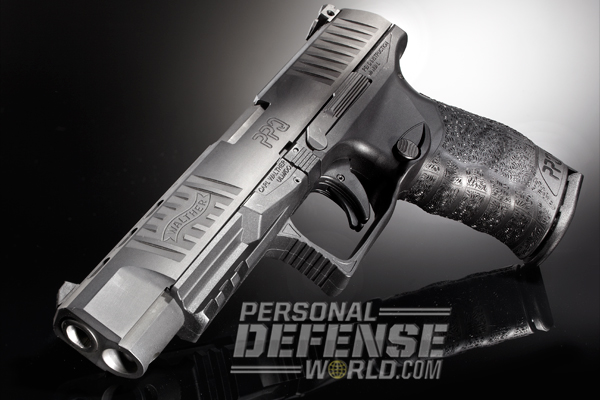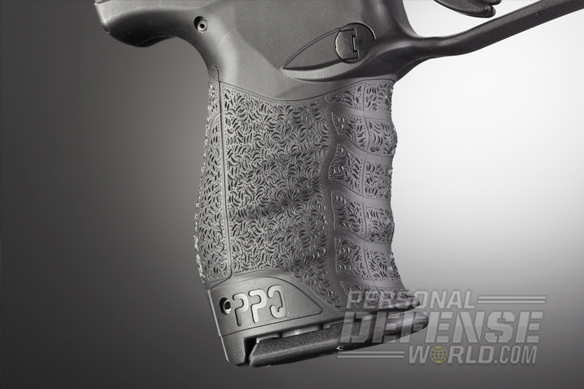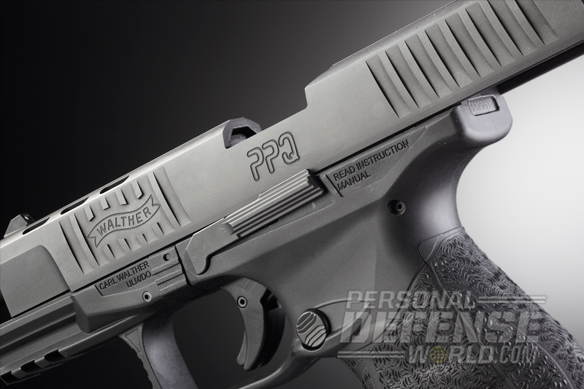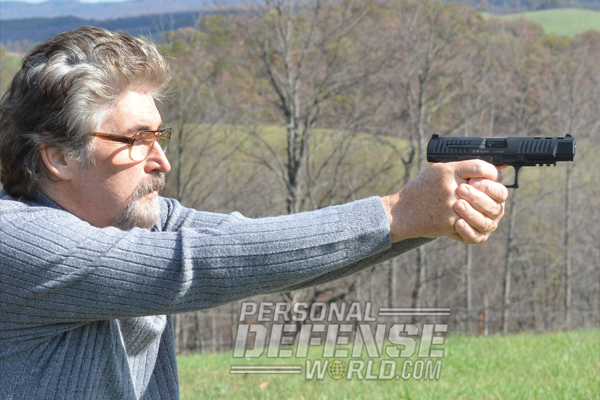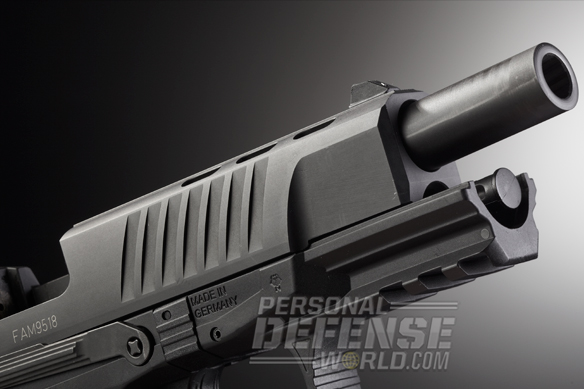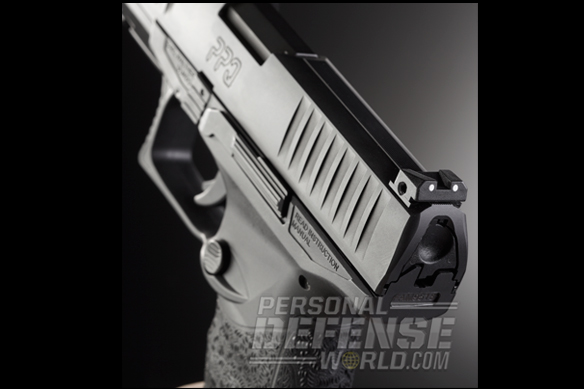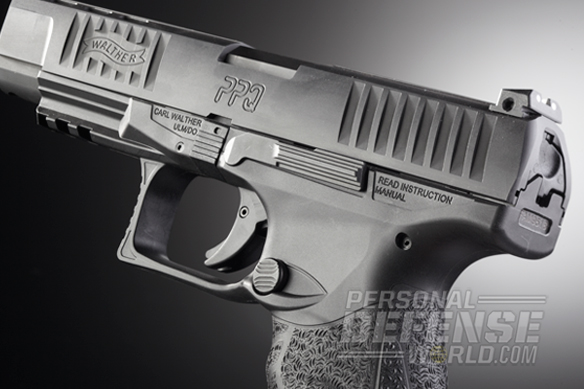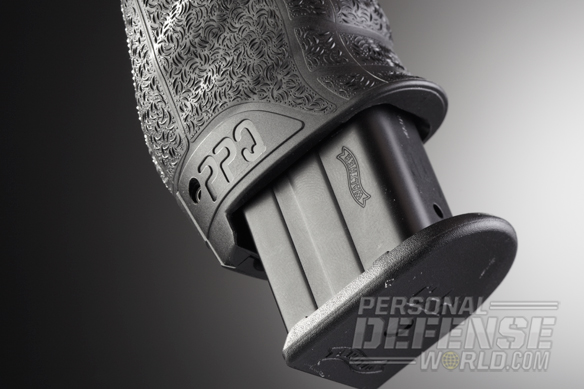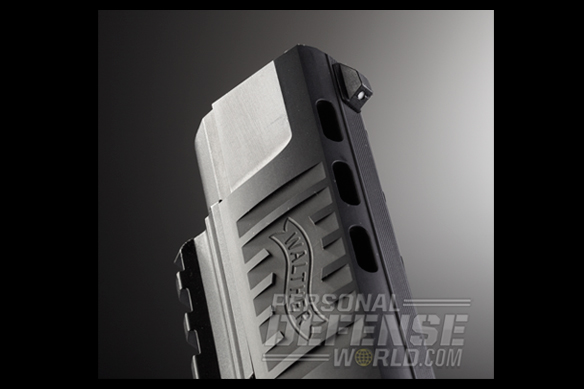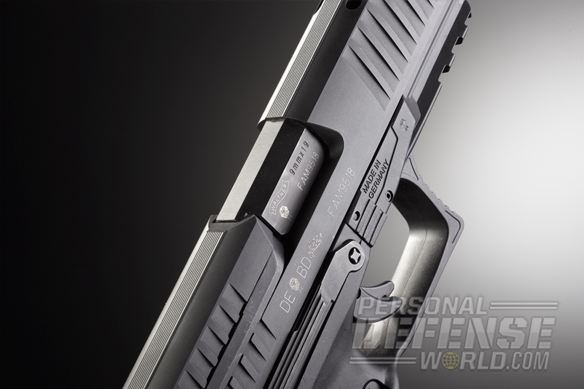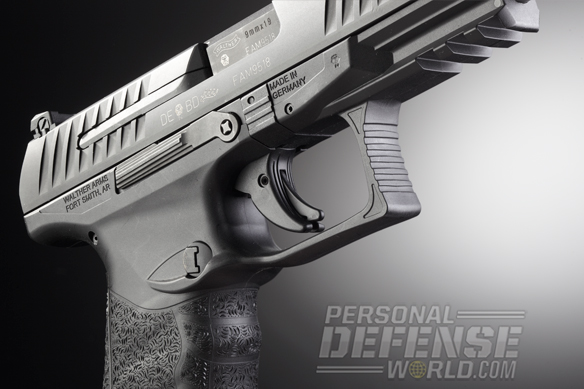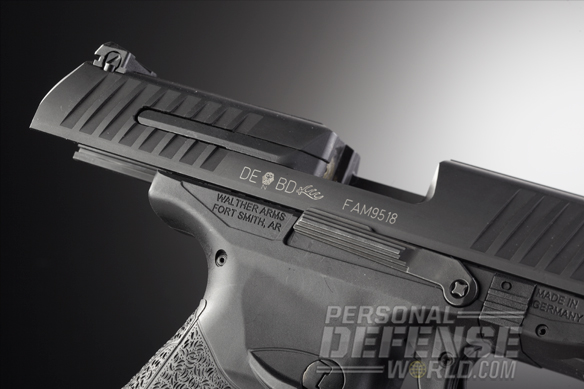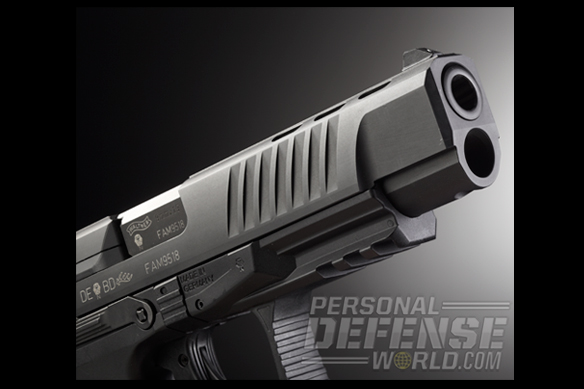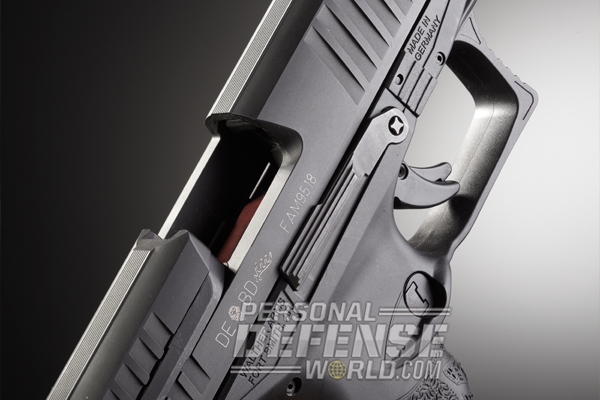Walther has taken its well-regarded PPQ M2 semi-auto pistol and elongated it, extending the barrel length to 5 inches to wring maximum performance from the gun’s 15+1 9mm payload. The PPQ M2 5-inch, also available in .40 S&W, features ambidextrous, elongated slide releases and a new frame-mounted magazine release button.
Almost everyone who has carried a Government model has dealt with the weight of the gun (36 to 39 ounces on average), which, over more than a century, has changed very little regardless of caliber (.45 ACP, .38 Super, 9mm, 10mm and .22 LR). The advantages of a full-sized, 5-inch-barreled, semi-automatic pistol have also changed little in the last 100 years—the longer sight radius, excellent balance in the hand, improved accuracy (with target sights) and reliability. These are qualities that have not only made the 1911 the world standard, but also perpetuated its design into the 21st century. What, you might ask, has this to do with Walther’s latest 9mm? In the case of the PPQ M2 5-inch, the answer is everything.
CLICK HERE for more Walther Handguns!
Advertisement — Continue Reading Below
GUN DETAILS:
For the legendary German arms-maker, this is not a typical handgun, not even by the standards of the company’s PPQ design, introduced in 2011. The very latest development of Walther’s polymer-framed P99-based semi-autos, the PPQ M2 5-inch, by virtue of its 1-inch-longer barrel and slide, puts it into a category of handguns generally served by Colt and other 1911-style pistols, as well a handful of 5-inch-barreled tactical semi-autos and sporting models, including the polymer-framed Glock 34 and 35. It does not, however, fall into the category normally associated with Walther’s polymer-framed 9mm semi-autos. For example, the longer 8-inch slide on the PPQ M2 5-inch is ported with six heat-dissipating vents. It has easy-to-operate, elongated, ambidextrous slide releases, adjustable white-dot target sights and a large, round, button-style magazine release. The magazine release is brand new. (Previous polymer-framed Walthers, including the PPQ, have utilized the ambidextrous, triggerguard-mounted magazine release first introduced on the P99.) It is a noteworthy change to the gun’s fundamental design (thus the M2 designation). Unfortunately, while the new button-style release is reversible for left-handed shooters, it is not truly ambidextrous like the original triggerguard paddle release. According to Walther research, consumers prefer a traditional grip-mounted magazine release. For many who have previously owned and carried P99 models and P99 variations like the 2011 PPQ (M1), it seems like a step backwards.
CLICK HERE to scroll down or see the VIDEO!
SPECIFICATIONS:
Advertisement — Continue Reading Below
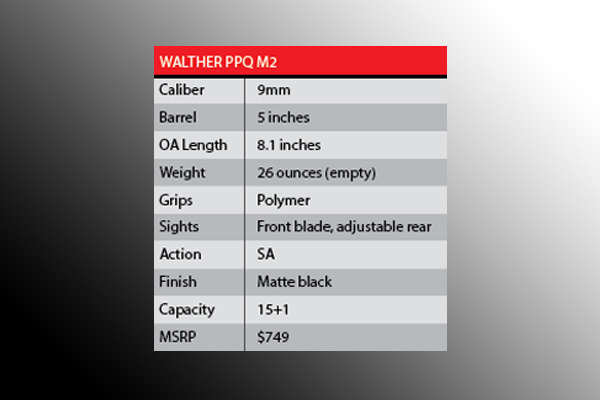
Differing opinions aside, the new, large button release is a well-thought-out design, set beside a deeply relieved surface that makes accessing the release easy and above a ledge that prevents inadvertent activation. It is also easy to operate, with only modest effort required by the strong-hand thumb. Were it ambidextrous, instead of reversible, it would be better. But for those more familiar with Government-sized pistols, the traditional magazine release may actually be an asset.
The striker-fired PPQ M2 utilizes a traditional short-recoil, locked-breech design, incorporating a modified Browning locking system that has the barrel engaging the slide with a single, large lug. The principal difference between previous Walther single-action/double-action (SA/DA) and double-action-only (DAO) models and the PPQ series is the latter’s use of a Glock-type safety incorporated into the trigger mechanism. Walther calls their variation the “Quick Defense” trigger system, which was first seen on the P99 QA. While most striker-fired semi-automatics using this type of trigger safety are designated as DAO (such as Glocks), in practice they all function as SAs. Once the trigger is pulled, it will not reset unless the gun discharges and the slide cycles through its operation to reset the trigger and partially pre-tension the striker. A true striker-fired DAO or SA/DA (like the Walther P99) will allow the trigger to repeatedly operate without either prerequisite. Thus, the PPQ M2 is technically an SA.
Walther’s implementation in the PPQ M2 of the “Quick Defense” trigger also does away with the P99’s decocking system, which allowed striker-fired Walther models to be decocked with a chambered round and thus carried in a “safe” condition. Walther literally instituted this design in the 1930s with the first hammer-fired 9mm pistol to feature a decocking lever, the P.38. However, unlike the P.38, the P99 and all subsequent models based on its design are striker-fired, and once decocked the first shot must be fired DA. (One can also pull the slide slightly to the rear and reset the striker. This also applies to the new PPQ series.)
Advertisement — Continue Reading Below
A primary feature of the SA/DA or DAO design, however, is second-strike capability in the event of a failed cartridge primer. So the trade-off with Walther’s new “Quick Defense” trigger comes down to a matter of weighing the odds that a cartridge primer will fail and, more to the point, that a second strike will successfully fire it. The time it takes to partially cycle the slide to reset a striker (about 0.5 inches on the PPQ M2) versus simply pulling the trigger again (on the P99 and PPX) is the fundamental difference. Ultimately, this becomes a matter of personal preference in gun handling and whether one is comfortable with a trigger safety versus a decocker, manual safety or DAO trigger. Given the number of handguns now using the Glock-type articulated blade trigger safety, that question seems to have answered itself.
Ideally suited for target and practical shooting, the 5-inch PPQ M2 has adjustable, low-profile white-dot sights that are very easy to acquire. The polymer frame and grip angle are ideal to maintain a low bore axis and come with two interchangeable backstrap panels to accommodate different-sized hands. The width and height of the 5-inch model are otherwise identical to the standard 4-inch PPQ M2. However, the integral Picatinny rail, combined with the added slide and barrel length, allows a little more room for tactical lights or combination light/laser systems behind the extended muzzle. And the oversized triggerguard leaves plenty of room for a gloved hand to safely operate the trigger.
The biggest advantage of the 5-inch model, however, is its weight. Remember that most Government-sized semi-autos have steel frames and tip the scales at around 39 ounces. The PPQ M2 5-inch weighs in at just 27 ounces empty with a 15-round capacity magazine (or 11 rounds in .40 S&W). That’s an average of 17 ounces less than a comparably sized 5-inch-barreled, steel-frame, semi-automatic pistol.
Advertisement — Continue Reading Below
RANGE TIME:
One of the first things you become aware of when loading the PPQ is the ease with which the ambidextrous slide release operates, requiring only modest effort with either hand. The trigger pull is short, with only 0.5 inches of total travel (including the trigger safety); there is zero overtravel, and reset is very quick. Overall, this is exactly what you want from a striker-fired semi-auto with this type of trigger safety. Trigger pull on our test gun averaged only 5.15 pounds. The adjustable white-dot rear sight and fixed white-dot front sight on the 8-inch slide present an excellent sight picture under most lighting conditions. Walther also offers low-light sights as an option, but I found the standard sights very easy to acquire.
One of the great features of a 9mm semi-auto is its ability to handle a wide variety of ammunition—from good, old-fashioned full metal jacket (FMJ) to the latest in defensive and law enforcement loads like Hornady Critical Defense FTX, Federal Premium Hydra-Shok jacketed hollow-point (JHP) and Speer Gold Dot to standard Winchester 9mm FMJ—without a hiccup. Test ammo for the PPQ M2 consisted of heavy-hitting 124-grain Federal Premium Hydra-Shok JHP, 115-grain Hornady Critical Defense FTX and the more affordable but equally reliable Winchester 115-grain FMJ, which comes in a 100-round value pack.
With a ProChrono chronograph set up 10 feet from the muzzle, Federal Premium 124-grain JHPs cleared the traps at 1,140 feet per second (fps), Hornady 115-grains clocked 1,210 fps, and Winchester 115-grain FMJs flew downrange just a hair quicker at 1,215 fps. Using a Weaver stance and a two-handed hold (no benchrest), the long-barreled Walther delivered a best five-shot group of 1.93 inches with the Hornady 115-grain. The widest group measured just 2.73 inches with two pairs of overlapping shots. Switching to hard-hitting Federal Premium Hydra-Shok, the 124-grain JHP rounds also averaged a best of 1.93 inches. With Winchester 115-grain FMJs, groups averaged 2.25 inches. In view of my having fired the gun off-hand from a distance of 75 feet, those are all respectable groups. Shooting this gun from a benchrest would easily return 1.25-inch groups for the effort.
Advertisement — Continue Reading Below
FINAL NOTES:
I have owned Walthers since the 1970s, and everyone has been an exceptional firearm. For a 127-year-old company that, for all intents and purposes, invented the SA/DA 9mm pistol and de-cocker, to change from that platform to the PPQ design speaks volumes about Walther’s openness to new ideas, even when those ideas abandon two of the fundamental tenets of designs dating back to the 1930s. However, what the PPQ gives up is equally offset by what it gains. The PPQ M2 is as bold for 2013 as the P99 was in 1996, and the addition of the 5-inch M2 version adds yet another layer to this exceptional new series of Walther semi-auto designs.
CLICK HERE To Return To First Page!
Advertisement — Continue Reading Below
For more information on the Walther PPQ M2 5-Inch Pistol, visit waltherarms.com or call 479-242-8500.
